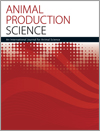
Animal Production Science
Volume 63 Number 13 2023
AN22468Risk management in pig farming: a reality or conjecture? A systematic review
 , Fabiano Gregolin
, Fabiano Gregolin  , Késia Oliveira da Silva Miranda
, Késia Oliveira da Silva Miranda  and Késia Oliveira da Silva Miranda
and Késia Oliveira da Silva Miranda 
The complexity in swine production demands management actions that are equally complex. An area that may significantly help pork producers with their decision-making is risk management. A systematic review was carried. The searches resulted in 2178 documents on the theme risks in pig farming. The results showed that risk is a growing theme in the area but they were not approached in a holistic manner through specific methodologies that would allow identifying, measuring and managing risks in a consistent and systematic way and thus be characterised as risk management.
AN22342Selection for yearling growth rate in Angus cattle results in bigger cows that eat more
Breeding cattle for faster weight gain is effective in changing the size of animals, but can increase cow size and feed requirements, which may be undesirable. This experiment showed that selection for growth rate increased cow size and feed intake, with improvement in the feed efficiency, but not energy efficiency, of the cow–calf unit. Breeding programs that are accompanied by an increase in cow size need to be cognizant of the increase in cow feed requirement.
AN23153Effects of hydroxyapatite nanoparticles on the vitrification of bovine metaphase II oocytes
 , Xiao-Jing Wang, Jia-Qi Liu, Shi-Yu Zhao, Zhi-Qian Xu, Xiao-Xia Li, Ying-Hua Li and Xue-Li Yu
, Xiao-Jing Wang, Jia-Qi Liu, Shi-Yu Zhao, Zhi-Qian Xu, Xiao-Xia Li, Ying-Hua Li and Xue-Li Yu 
Nanotechnology is of great value in the field of medical biology, but the intersection of nanotechnology and cryogenic bioengineering has not been studied enough. HA nanoparticles were added to the cryoprotectant of bovine oocytes in our study. We found that a certain concentration of nanoparticles had a positive effect on vitrification and postfreezing development capacity. Nano-vitrification of oocytes deserves further exploration in both theory and practice.
Omega-3 fatty acids can have important health implications and are associated with altered reproductive efficiency in sheep. The rate of depletion of omega-3 with different grain types was previously unknown; however, results from the current study showed that depletion is similar with oats, wheat, lupins and barley, although some changes in red blood cells were not as great for barley compared with other grains. The effect of these changes on fatty acid concentrations in meat and reproductive outcomes should be investigated further.
The outlook for Australia’s sheepmeat industry is very positive, with a significant opportunity available to further increase the supply of premium sheepmeat products to customers, by more rapidly rebuilding the national flock. This paper presents the findings of a study focussed on providing the confidence and material to sheep producers to choose optimal pathways to rebuild their flocks. At least 6 of the 14 alternatives investigated were deemed suitable for commercial use and not sensitive to variations in supplementary-feed costs, stock-purchasing and -sale prices.
AN22121 Abstract | AN22121 Full Text | AN22121PDF (1.6 MB) | AN22121Supplementary Material (1 MB) Open Access Article
AN22313Effects of shading on tropical grass characteristics and cattle performance in silvopastoral systems: systematic review and meta-analysis
 , Guilherme Lobato Menezes
, Guilherme Lobato Menezes  , Lúcio Carlos Gonçalves, Vânia Eloisa de Araújo, Matheus Anchieta Ramirez, Roberto Guimarães Júnior, Diogo Gonzaga Jayme
, Lúcio Carlos Gonçalves, Vânia Eloisa de Araújo, Matheus Anchieta Ramirez, Roberto Guimarães Júnior, Diogo Gonzaga Jayme  and Ângela Maria Quintão Lana
and Ângela Maria Quintão Lana
Silvopastoral systems (SPSs) are recognised for good production and environmental indicators, but excessive shading and competition for water in the systems with a high tree density reduces forage mass and can reduce animal production and profitability. We performed a meta-analysis with studies in tropical climates and observed that in SPSs with Eucalyptus with more than 28 m between the rows, and with leguminous or with palm trees, the animal performance was similar to that of monoculture pasture. The results showed an increase in the total production of the system, which may encourage implementation of SPSs on commercial farms.
Beef has a high emissions intensity due in part to the low reproductive rate of cattle. We evaluated if increasing the rate of twinning offers a pathway to reducing the methane intensity of beef by increasing biological efficiency, our results show that beef from twin reared calves has a 22% lower methane intensity. However, twinning is unlikely to be a viable net emissions reduction pathway unless a commercial or policy driver to reduce net methane emissions is established.
AN23088 Abstract | AN23088 Full Text | AN23088PDF (1 MB) Open Access Article
In this paper, we studied the chelation of sika deer blood polypeptide with selenium ion to prepare a new type of deer blood polypeptide–selenium supplement, which is more beneficial to human body in terms of safety and bioavailability than is the inorganic selenium supplement. The best chelating process was determined, and the properties of the chelate were determined by characterisation analysis and stability test. The results of this study provide a scientific basis for providing new selenium supplements.



